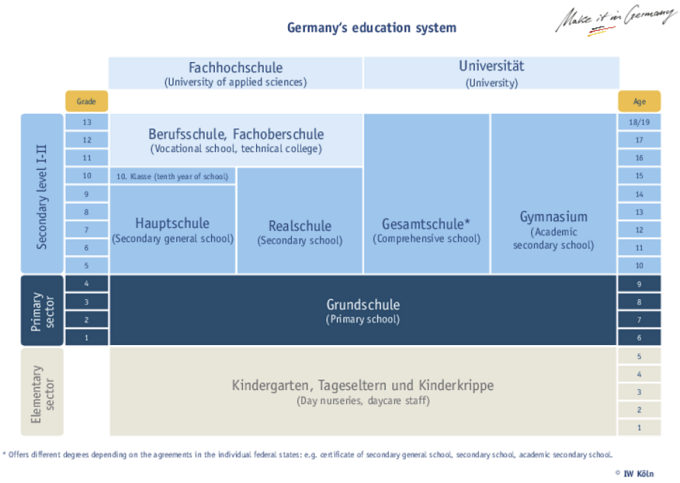Which Are the Teaching Methodology and Materials in Preschool Education in Germany?
For Children Under the Age of 3
The core educational mission of the German preschool education (age under 3) is the enhancement of communication skills amongst kids. Secondly, it is the development of their language skills through the social interaction with other toddlers and adults.
Communication and language skills are taught by language role model (educators), finger plays, singing, pictured books and additional teaching practices/instruments.
Furthermore, an important part in pre-educating children is given to the motor development. This includes increasing body awareness, self-acceptance, self-confidence and concentration amongst the toddlers.
Motor development is reached through physical activities, visiting public environments, rhythmic early education programs, singing and movement playing.
For the Children over the Age of 2
Core values that preschool education seeks to develop amongst children are the enhancement of their teamwork skills, along with their level of integration in daily life activities.
Key areas of German preschool education of children older than 2 are (1) language, writing, communication, (2) personal and social development, (3) development of values and religious education, (4) mathematics, natural sciences, (information) technology (5) fine arts/working with different media (6) body, movement, health and (7) nature and cultural environments.
Such values are taught through self-organized learning, creative learning, teamwork building activities, investigation and experimental activities.
German Primary Education
What Is Considered Primary Education in Germany?
Grundschule (primary school) offer mandatory education through mixed-ability classes for children of age 6 until they complete grade 4 (or 6 in Berlin and Brandenburg) of school studies.
There are two primary school education systems in Germany. In a 5-day school week pre-education system, there’re 188 teaching days/annually. In a 6-day school week preschool system, there’re 208 days of teaching/annually, by including also teachings during 2 Saturdays/every month.
Primary school pupils are obliged to attend 20 to 29 courses/1 week, and 20-22 /first year. Primary school courses normally last up to 45 minutes. During 1 day up to 6 courses can be taught.
Which are the Teaching Practices in Primary Schools in Germany?
The core objective of the German primary education is development of essential understanding, skills, abilities and key competences amongst pupils.
Subjects taught in German primary schools are German language, mathematics, general studies, foreign language, art, handicrafts/textile design, music, sports, and religion/ethics. They also teach intercultural, mint, media, health, musical-aesthetic, sustainable development, and values education.
Learning objectives in primary schools are attained through engagement of pupils in planning, running, analyzing study subjects (lessons) in an adapted way, which goes along with their knowledge, interest, curiosity and concerns. Students are also encouraged to take part in organizing initiatives and interdisciplinary projects of the school.
Primary school textbooks in Germany, used as study reference, have to be approved the respective Ministry.
People suffering long-term or permanent illness or physical incapacity who couldn’t attend primary education lessons they may well receive such education at their homes.
Moreover Germany offers special primary education scheme for children of the professional travelers, who cannot attend regular primary education. Schools like School for Children of Professional Travelers “Schule für die kinder beruflich Reisender” offer separate education for such group of children, during the period they’re not traveling.
There’s even a School for Circus Children “Schule für Circuskinder”.
Germany has also vocationally oriented primary education modules. This education is offered for the children of workers in companies/institutions such as EU project BeKoSch (Development of Professional Skills for Showmen through Modules).
What’s more, Germany has International Schools offering primary education through bilingual lessons in several languages, such as the European Schools.
Which Is the Grading System in German Primary Schools?
By completing lessons of the grade 1, children are automatically transferred to the grade 2, regardless level of knowledge attained during such studies.
Starting from grade 2, these children are awarded a suitable mark, in dependence to the level of knowledge they’ve attained during studies. If failing to pass the grade, children have to repeat the grade lessons once more.
In the Pupil’s school report “Zeugnis” is issued showing all the marks achieved during a school year, and according to that is decided whether the child will pass to the next grade or has to repeat the same grade.
The progress of pupils in German primary schools is evaluated upon a 6-mark grading system as follows:
- 1 (very good).
- 2 (good).
- 3 (satisfactory).
- 4 (adequate).
- 5 (poor).
- 6 (very poor).
Does a Pupil Receive a Primary School Leaving Certificate in Germany?
There isn’t any examination upon completing a German primary school. Thus, primary school-leaving certificate aren’t usually issued, except for the Lander Baden-Württemberg and Rheinland-Pfalz.
Instead, when pupils leave a German primary school they must have reached “the Grundschule target outcomes”. Accordingly, there are issued an annual report of their studies during 4th/6th grade.
What Is Considered Secondary Education in Germany?
German Secondary education takes place after the primary school, and it’s separated into lower secondary level “Sekundarstufe I” and upper secondary level “Sekundarstufe II”.
The lower secondary education is the education offered for pupils of age 10 – 15/16 in grades 5/7 to 9/10. Lessons in this level are of a general nature and serve as preparation for the upper level of secondary education.
The upper secondary education is the education that pupils of age 15/16 – 18/who have completed lower level of secondary school receive for the purpose of getting a university entrance qualification or a vocational qualification. This level resumes all the courses of lower secondary level which built the basis of knowledge of the participating pupils.
Germany has various secondary schools attended by children of various abilities and various prior qualifications received in primary education.
Which Are the Types of Secondary Schools in Germany?
Federal country of Germany offers secondary education in public and private schools.
Germany’s publicly-funded secondary schools are:
- German high schools issuing specialized qualifications in one study area.
- “Gymnasium”. Providing intensive and in-depth general education, general knowledge for university studies, and for scientific work. It normally covers schooling years from grade 5-12 or 5-13, leading to an “Allgemeine Hochschulreife” known as “Abitur”.
- “Hauptschule”. Teaching basic general education, leading to a vocational or university entrance qualification. Education in such school lasts from grade 5-9, and sometimes includes the grade 10 as well, leading to a “Hauptschulabschluss”.
- “Realschule”. Offering more extensive education, leading to a vocational or university entrance qualification. It usually covers schooling years from grade 5 to 10, “Realschulabschluss”.
- German schools with more than one study course “Schularten mit mehreren Bildungsgängen”.
They offer 2-3 different study subjects.
- German vocational schools. They offer lessons and practical placement, known as a dual system. These are the types of vocational schools available in Germany:
- “Fachoberschule”. Providing 2-year education to the holders of maturity certificate “Mittlerer Schulabschluss” leading to a “Fachhochschulreife”, entitling holder to enter a university of applied sciences. If a 13 grade is held in this institution, a pupil completing it can receive a “Fachgebundene Hochschulreife” or an “Abitur”.
- “Berufsoberschule”. Providing a 2-year general and in-depth education and training regarding initial vocational knowledge and training obtained during previous education, leading to a vocational qualification (or Abitur – by proving the good command in second foreign language). There is also a 3/4-year course of study which is aimed at getting a double qualification, both vocational and higher education qualification.
- “Berufsfachschule”.
Offering education for one or few professions which require formal recognition or leading to a vocational training qualification.
- “Berufsschule”. Delivering practically oriented and interdisciplinary lessons and skills, which prepare pupils for further vocational education or for a job in a profession. They do that based on the dual system, education and training combined.
- “Berufliches Gymnasium”. Providing a 3-year long secondary education program, leading to an Abitur.
Germany’s private secondary schools are the following:
- Alternative schools “Ersatzschulen”. Providing equal lessons and courses as public secondary schools.
- Complementary schools “Ergänzungsschulen”. Teaching additional courses, despite those that are also offered in the public secondary schools.
Which are the Objectives of the German Secondary Education?
Lower secondary education in Germany, as its core mission has the fundamental education, individual specialization, and identification of individual abilities amongst children.
German secondary education objectives are achieved by:
- Engaging children intellectually, emotionally and physically.
- Teaching them independence, decision making, as well as personal, social and political responsibility.
- Assisting them in attaining their educational goals.
- Supporting them in advancing their specialist knowledge.
General upper secondary schools in Germany aim to prepare youngsters with the needed understanding to obtain the Abitur or other university entrance qualification. With a university entrance qualification they can apply for further academic studies in any German higher education institution, or apply for a professional education and training study course.
Gymnasium offers youngsters with exhaustive understanding, expertise and know-hows for German and foreign language as well as Mathematics. These institutions also taught young people self-development, social responsibility, and participation in democratic society. Additionally, they’re informed and guided regarding academic institutions and their admission requirements, vocational sphere and access requirements, together with the employment prospect in various professions.
Upper secondary education offered during 2 full-time years by the German vocational high-schools “Berufliches Gymnasium” prepares youngsters to get a vocational qualification for a skilled work as qualified staff “Fachgebundene Hochschulreife”. Such qualification allows them to get a job in a profession requiring a formal qualification. The same time, such qualification can lead into a university entrance qualification, if the holder shows a good command on a second foreign language. Additionally, with such qualification the holder can study in a technical university, but before that, they’ve to study for 2 years until they get a maturity certificate “Mittlerer Schulabschluss”.
Which is the Grading system in the German Secondary School?
The progress of pupils in the German secondary schools is evaluated upon a 6-mark grading system as follows:
- 1 (very good).
- 2 (good).
- 3 (satisfactory).
- 4 (adequate).
- 5 (poor).
- 6 (very poor).
What Makes a Tertiary Education in Germany?
German tertiary education in Germany provides higher education for qualifying individuals, who before all, have completed secondary education in Germany or abroad which entitles them to enter higher education studies.
Who’s Responsible for Supervision of German Tertiary Education?
Higher education institutions under the Basic law enjoy the autonomy to independently manage the scholarship awarding, research and teaching activity.
For administrative issues, such as academic and governmental matters, these institutions have to be in accord with the Lander’s ministry.
Which Are the Institutions of German Tertiary Education?
Higher education studies (tertiary education providers) in Germany are named the recognized institutions providing higher education study courses leading to a profession that addresses needs of the local and international labour market.
Germany’s education providers, recognized as Higher Education Institutions are:
- Universities “Universitäten” and Equal Institutions.
- “Technische Hochschulen”/”Technische Universitäten”.
- “Pädagogische Hochschulen”.
- Theological colleges.
- Universities of Applied Sciences “Fachhochschulen”.
- Art and Music Colleges.
- Higher Education Institutions for Federal Armed Forces.
- Higher Education Institutions Offering Dual Studies “Berufsakademie” (BA).
- Institutions of Continuing Vocational Education “Fachschulen” And “Fachakademien” In Berlin. According to the International Standard Classification of Education (ISCED), the education received from these institutions is equal to the first level of higher education.









